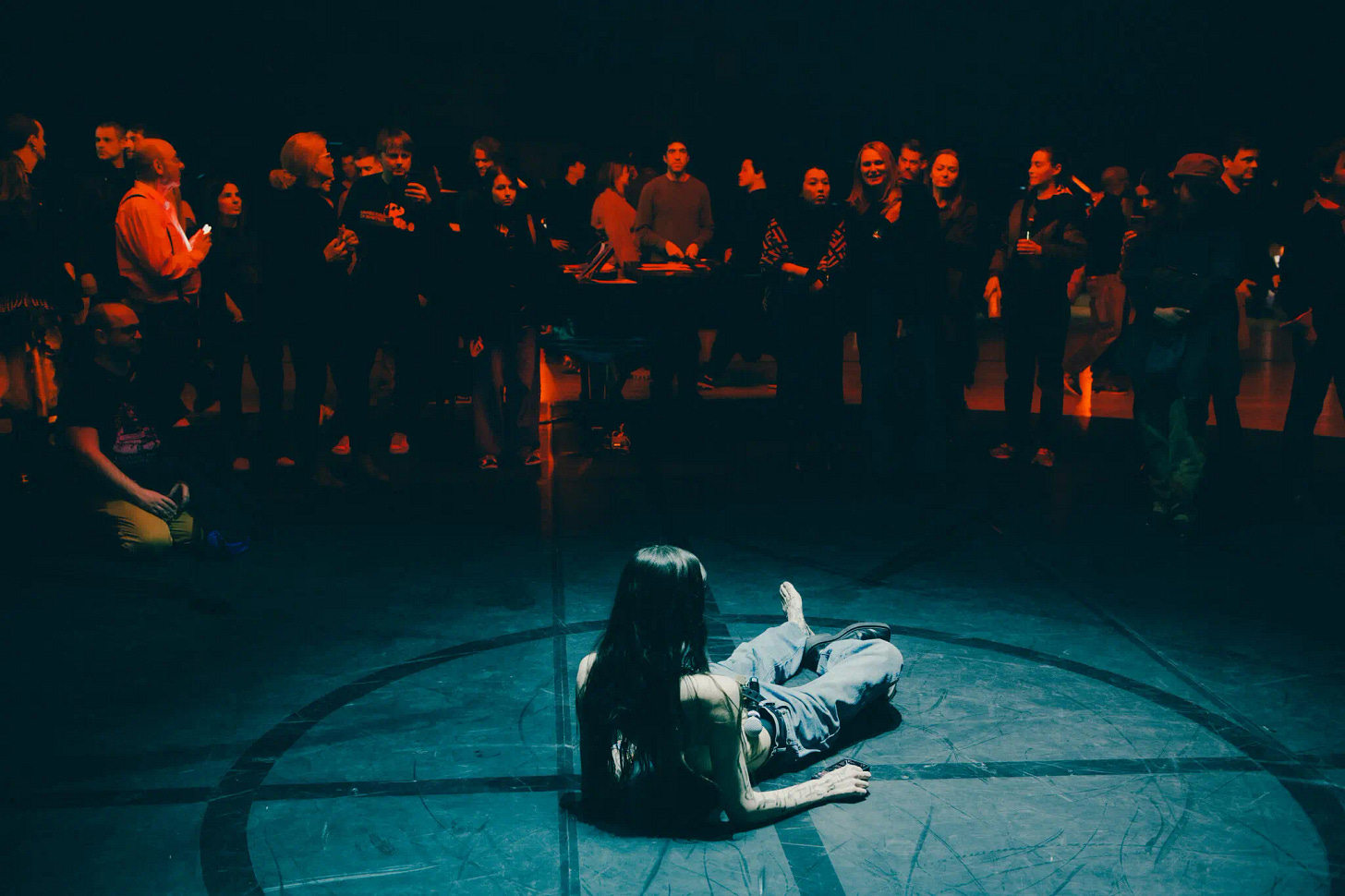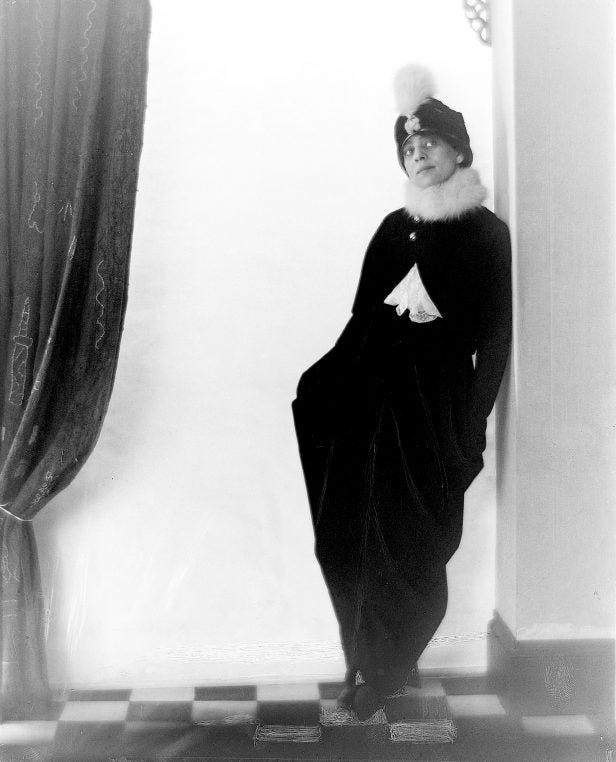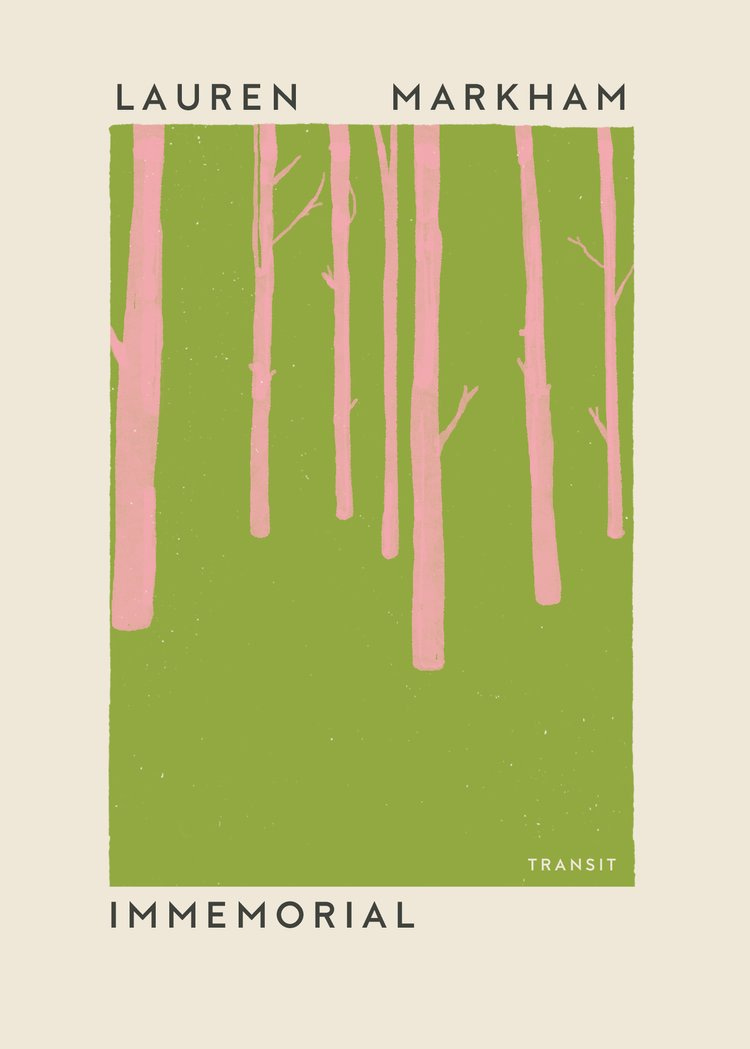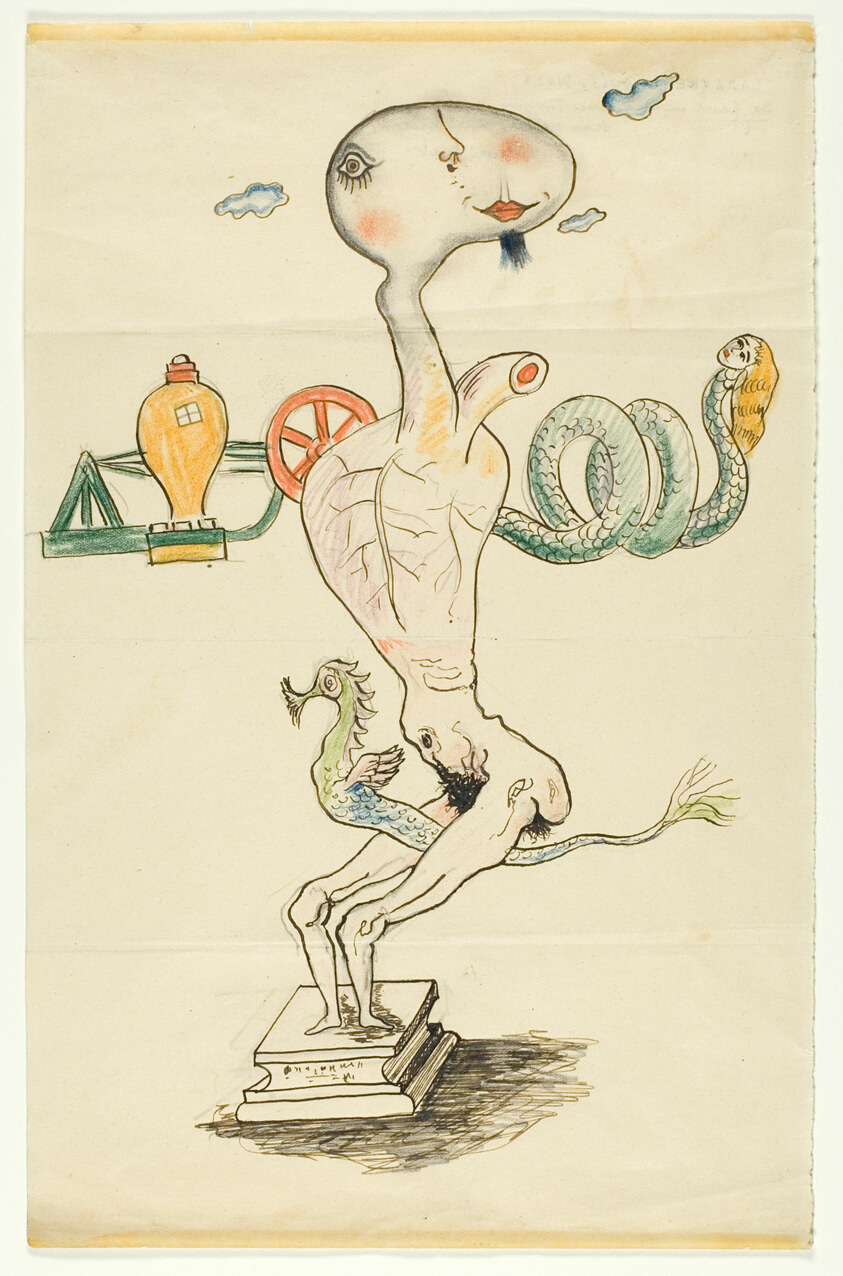THE ART OF DOOM
Any durational performance centered around an enormous countdown clock announcing the remaining time until the end of show has either got a sense of humor or a sense of sadism. Anne Imhof’s ten-day-run of DOOM: HOUSE OF HOPE at the Park Ave Armory didn’t have either. So if you weren’t entertained, at least you weren’t punished or trapped—audiences were free to choose how to spend the three hours ticking past on the Jumbotron hanging from the ceiling. Letting people wander or leave is very important/benevolent if you are not going to mesmerize them. No rapture, no capture!
As the performance started the audience was smushed behind crowd-control gates at the entrance, craning around to see into the massive drill hall where the Armory hosts mega shows. Imhof’s well-known cast of performers crawled up onto a bunch of parked cars and started chanting the word “doom.” The music that began at this point snapped me into my body: sinister, uneasy, then melodramatic then lovely then weird. I wrote on my phone: Portishead? Nine Inch Nails? Bach? The music (scored by Ville Haimala) evolved and mutated wildly throughout the night, undergirding the dispersed events and keeping things cohesive: more than any other element, the sound made it one experience.
The clock itself, like most signifiers throughout DOOM, was overdetermined. You knew what it meant at first glance and it didn’t demand a second. It was about durational performance, about American athletics and competition, and it was a countdown to the end of the world. When released into the enormous hall, we were allowed to wander around dozens of gleaming black Escalades parked around the floor, a dealership/showroom full of vehicles that no one can afford (except, well, the Armory, possibly because tickets to the show cost $50). Got it: post-human landscape, commodity fetishism, techno fetishism, warehoused capital, wasted youth.
Imhof’s traditional dead-eyed hot people wearing rhinestoned sweatpants, jeans held up by skinny belts, or miniskirts with kneesocks roamed around the cars and made you feel kind of old even if you were younger than them, reciting lines from Romeo and Juliet, playing piano, or breaking into classical ballet. Fashion, nihilism, formalism. A tinge of relational aesthetics, if you want to get into that (I don’t think anyone does). The performers chanted alternately: DOOM. WE HOPE. A solid binary. No deciphering. The Armory’s stunning 55,000-foot installation space is already overdetermined just because it was built in the 1880s for a volunteer Union militia to train in. As my evening companion put it: the Armory is a venue where the house almost always wins.
When I told one friend I was going to see the Imhof (which had been advertised to the extent that I saw a poster in my bodega window!!) he asked: “She’s allowed to do that here?” Meaning: it’s not so contextually overdetermined as Euro that it will translate in a manner legible to ye American normies, wokes, and reactionaries? Imhof’s aesthetic is Gold-standard Euro (literally: she won the Golden Lion at Venice) but she has actually been here before: in 2015 she said of her own show at MoMA PS1, which bothered animal-rights activists because it was full of live rabbits: “It was somehow too early for me to face the U.S. If I had known America better, I would never, ever have done a piece like that.”
As an art person grown in Berlin I was looking forward to the show for exactly that reason: a slice of home! I did feel comfy there, even nostalgic for the club days. I felt floaty and chatty and a little stoned; I wished there was a smoke machine. But in the last hour the high mellowed as the visual language slid into pantomimes of Americana: prom singers jamming onstage in high-school mascot sweatshirts and cheerleading uniforms, a Ralph-Lauren/Benetton group photoshoot pose. It didn’t have to be about America, did it? Provoking animal-rights activists is probably a more trenchant mirror-to-the-nation than staging a prom.
Maybe that’s why the available readings and hot takes on DOOM likewise feel overdetermined and rote. Most that don’t seem fawning, defensive, or offended have landed on shruggy ambivalence sort of like mine. I will rest most of my opinions on the only thing you actually need to read about it: Domenick Ammirati’s last, best essay, which is indeed the best but not in fact the last, as evidenced by what I am doing now, in which he says: “Lots of people have been excited to say scathing things about the show; lots of people were ready to advocate on its behalf. I kind of want to do both.”
Same. My desire to play both sides made me realize that, for a show set in a sportslike arena, these performers were playing defense, not offense—defending against complaints that someone somewhere (who, the animal rights people?) might levy. One complaint that people have made before, which misses the point, is that Imhof is not conversant in the history of Important Performance Genres like ballet, theater, opera, etcetera. Who cares. And it’s too late: if an artist adds those things for the sake of it, she makes empty referents to something Serious, ending in self-seriousness.1 The other complaints that people have made (vapid; nihilistic; authoritarian; the models are too [something]; just fashion; just vibes; just Eurocore) are all obvious and too easy (several reviews are occupied with just listing them). The problem with playing defense is that a) anticipating the complaints legitimizes them and undermines the integrity of the project and b) if the art is not doing those things, what is it doing?
Again, per Domenick, what the show is doing is being SOCIAL (“the most fun thing of all about Doom was that you could talk”) and SOCIALLY MEDIATED (it’s quintessential shareable content that looks incredible online and everyone wants to talk about it). The best Imhofs appeal because of how they fill space with bodies, they make you focus on the types of bodies occupying that space, they give you an uncomfortable feeling of emptiness and fulness, of entertainment and boredom, of presence and absence, and you vacillate between feeling excluded and included in the group vibe or the scenography or the synergy. It has a recognizable mouthfeel. You carry that feeling with you when you leave, either in your body or in your phone. The work lives in the world and circulates. To do that, it relies, intelligently, on the circulation mechanisms already in place (again tho: my bodega?) and in that sense calling Imhof a “disruptor” is not doing her any favors, because that would demand she and we all reckon with what needs to be disrupted—probably the art market? Or the attention economy?—which this work is not disrupting and doesn’t want or need to. It is using those things as mediums and, at best, running the code backward.
DOOM gave me a mild body feeling and a few hours to spend with a friend, and I didn’t feel the need to take pictures because I knew there would be plenty online. As I was leaving to drink a bootleg martini in the break room, I saw a model who I am 99.99% sure was not a hired performer, posing in what looked like Yeezy spandex amid the headlights of an Escalade, for a guy quickly snapping iPhone pics. The Armory docents eventually noticed them and gently ushered them along. Loop, close thyself.
DOOM OF HAVING TO HAVE AN OPINION
In a Substackless world I would PROBABLY NOT write about DOOM. I had plenty to say, but then so did a lot of smart people, and I cannot be burdened by the need to comment on The Culture. That’s how you end up wearing a cheerleading uniform in a drill hall. When a subject feels overdetermined, I always prefert to listen to other people determine it first. (The one time I agreed to write about Moshfegh, Andrea Long Chu nailed it way better ten mins later.) Also as I said last week: the art world that everyone is already looking at is not necessarily the interesting one, and even if it is interesting, pointing to it kind of just reinforces the idea that the talk is the art. Disturbing for anyone who relies on art for money; also disturbing for anyone who knows how arbitrary buzz can be. But then buzz is what this particular show is about.
HUMAN DOOM
One reviewer noted that his experience at DOOM “uncomfortably recalled a police tactic known as kettling, in which protestors’ movements are restricted, often so that it is easier for cops to arrest demonstrators.” Two days after I went to the Armory, I ended up at Columbia, where student protestors were being penned in by very similar crowd-control devices as the ones used to keep spectators contained at the art show.
I had realized there was going to be a protest at Columbia when I planned to go see an art show there and had to arrange to get a QR code just to enter campus. I saw the art show (keep reading) and then I stayed at the protest for a long time. The protest was in response to the recent expulsion of three Barnard student protestors; at this point the protests are about protests, but this does not distract the student movement from what they are actually protesting, which is genocide. The students were organized, prepared, careful, clear. I cried.
During the gathering, attended by faculty and surrounded by a WILD number of security staff, someone got pulled out of the crowd. A campus officer demanded to see the man’s ID. Even after he showed it to them, they continued to threaten him and hold him separate from everyone else. He calmly repeated that they were profiling him because he was Palestinian.
Two days later, ICE kidnapped that student as he was returning home from dinner. In case you’re not already asking: “Why isn’t The Entire Country Terrified by the Arrest of Mahmoud Khalil?”
OCEAN DOOM
If they’ll take your land, they won’t stop at the water’s edge. Who owns the sea? Columbia GSAPP’s exhibition space is showing a longterm project called Prospecting Ocean by by artist-researcher Armin Linke (who has also been a resident at CERN) about the deep sea as a zone for territorialization and extraction by countries and companies who want to get at those resources down below. You can imagine this legal and logistical process is complex due to it being water. The exhibition includes an excellent film depicting “United Nations assemblies, international law conferences, marine research centers, deep sea mining companies, gatherings of decision-makers that are usually closed to the public, as well as activist meetings in Papua New Guinea.” If you want to know more without acquiring a QR code, co-curator extraordinaire Stefanie Hessler has written a whole book springing from Linke’s work.

I first got interested in the weirdness of deep sea mining when I saw a talk by art collective Inhabitants (member Mariana Silva wrote a SUPER piece on it). That’s how I became aware of the PRECIOUS NUGGETS called POLYMETALLIC NODULES that look like POTATOES scattered across the deep sea floor. They take millions of years to develop and are full of copper and manganese which are used to make things like circuit boards and rifles. Unfortunately it is important not to ruin the ocean by scraping around in it for reasons such as planetary extinction, so you can imagine the problem. All of these research projects point to the ocean being the final frontier for dispossession, colonization of “empty space,” tapping those laaaast resources from the planet—EXCEPT of course: OUTER SPACE. The way the ocean is being divvied up is a reflection/testing ground and roadmap for how to get the Tesla flag on Mars and how to design the seasteading version of a spaceship.
THE FIRST DOOM
You can go see when this all started in an exhibition of medieval manuscripts at the Morgan Library, still my fav place to consume exhibitions in New York (except for the Korean take-out displayed ostentatiously in heated cabinets a few blocks away at Woorijip). The exhibition is called The Book of Marvels and features two of the four remaining copies of the fifteenth-century French manuscript of that name, which shows wacky imaginings of people, places, and creatures beyond Europe. Within that collection you can see the apocalyptic marvel of Christopher Columbus’s first manuscript depicting the Taino people (“Indians”) whom he encountered on his first voyage. You can literally go look at a picture of when the Anthropocene started!
REALITY DOOM
The country really IS divided. During this season of Love is Blind, TWO WHOLE WOMEN said I don’t to their betrotheds at the altar because they had slowly realized that their betrotheds hated women, gays, abortions, Muslims, and [more examples not shown on camera]. The women were patient during their five-week engagement periods while trying to understand their fiancés’ points of view on these complex topics, but by wedding day they understood that their fiancés wanted to murder them.
During the reunion episode the men said things like: “I respect her views” and “I don’t think people have to agree to love each other.” The newly nazi-haired Nick Lachey referred to the women as hardcore SJWs for the dumpings that they had perpetrated. Is there anything to analyze here or is it all pretty straightforward? Can Anne Imhof make an artwork about this? At least one mystery remains: Is that really Nick Lachey or is it Nickey 17?
AND NOW FOR SOME GOOD THINGS
Also at the Morgan Library
You must see this curatorial masterclass of an exhibition on the life of the library’s first librarian: Belle da Costa Greene. Her idiosyncratic genius for languages and manuscripts led her to amass the library’s entire founding collection—she bargained a $1,500 deal for the only manuscript of The Raven? She bought the library’s first medieval Ethiopian manuscript? How did she get a letter from a Salem witch hunt survivor?—but it’s also an artifact-based narrative of race and class and passing and historical revisionism in early 20th-c USA. I mean:
Trust me on this
Because nobody has lifted the ban on reviewing your friends’ books in magazines yet, I have to tell you about these very important books on Substack.
My writing group has produced a BUMPER CROP this season. THREE WHOLE books from my group of seven writers are coming out.
I can’t begin to explain the miracle that is Writing Group. Is love blind? No, love is a close reading of a bad draft. If you don’t have a Group you should start one (while acknowledging that it can never achieve the synergy of This Exact Group).
The most recent products of this hive mind that are actually the products of INDIVIDUAL GENIUS and that I have had the honor of reading from .docx onward are:
I defer to an objective reviewer of Vijay Khurana’s THE PASSENGER SEAT: this “unsettling and powerful debut novel follows two teenagers on the fragile cusp of manhood in a Canadian border town… Things go pear-shaped, then the pear goes rotten as the boys harbor resentments, thwart each other and secretively plot.” Or, from my own blurb: “Khurana is a brilliant stylist who drives straight toward the heart.” VIOLENCE. THRILLS. HOMOSOCIAL BONDING. ROAD TRIP. NOT YR AVERAGE BOOK ABOUT [TOXIC] MASC.
I have already waved a flag about Madeleine Watts’s book ELEGY, SOUTHWEST, but I will do it again. I defer to Leslie Jamison this time: “This book is a fever dream, a mood, a spell, an entire climate filled with a particular kind of desert winter light— harsh, unsparing, and beautiful. Honestly, I feel that part of me is still actually living in the book. Tremendously moving.” AMERICANA. AUSTRALIANA. LOVE. BLOOD. THE OPEN ROAD. CACTUSES / CACTII.
The third group-baby of the season, POOR GHOST! by Gabriel Flynn, teased above, will be duly advertorialized here it when it comes out in May.
To prove this is not only nepotism
I took myself to a book launch for an author who I was not [yet] friends with that was excellent. Reading now: Immemorial by Lauren Markham, “A speculative essay on language in the face of climate catastrophe: how we memorialize what has been lost and what soon will be, pushing public imagination into generative realms.”
Corpse novel
A friend who runs the special bookshop San Serriffe in Amsterdam arranged for a bunch of writers to write a mutant novel via the classic Surrealist CADAVRE EXQUIS concept, where you read what came before your bit and Frankenstein your own chapter onto it. The option to spread the accountability around multiple bylines? Honestly, great invitation. Especially if you get to write the torso or the ass.
One last doomful recommendation
Vijay Masharani’s article for the recent issue of Parapraxis is basically M. Night Shyamalan for anyone doing psychoanalysis. Read Not Nothing and Not Something: Leukemia and rewriting a failed analysis.
Domenick contends rightly that this particular show is ironically “saved by dance” because there’s some good dancing; but along with the dancing was a reading of a 1994 piece by New Yorker dance critic Arlene Croce. Defense or offense?













You're too kind!